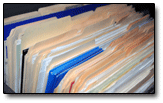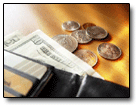Lately I’ve been kicking around the idea of going “95% digital” for my household’s record-keeping.
Because digital storage is dirt cheap these days, my idea is to purchase a scan-to-PDF machine (such as this Fujitsu ScanSnap S1500 , or its little brother, the ScanSnap S1300
, or its little brother, the ScanSnap S1300 machine), and gradually get away from paper record-keeping as much as possible.
machine), and gradually get away from paper record-keeping as much as possible.
Status Right Now: Paper Is … Okay
We have what seems, to me, to be a pretty good paper filing system right now. It’s been a long time since I wasn’t able to find what I needed pretty quickly. A couple of filiing cabinets, plus lots of manila folders, work quite nicely.
Truth be told, the reason I’m considering this move is that most all of the banks we deal with offer perks for going paperless — and I’ve always signed up. So I’ve already taken our bank-statement filing into the digital realm. On balance, this has worked out nicely. I’ve got statements going back a few years … and no paper copies to shuffle through should I need to find something.
Everything else, though, is still paper. Which means it takes up space.
Considerations: Backing Up and Retrievability
Hard drives crash. Your teenage son decides to use your laptop as a Frisbee. Your house becomes target practice for a lightning storm and catches fire.
Stuff happens.
The trick is: What do you do about it beforehand? Well, you try to plan for contingencies.
So, as far as backing-up your records, it sure seems that digital files would be FAR easier to maintain on an ongoing basis. In case of a house fire, for instance, whatever’s in our filiing cabinets would be quickly rendered to ash.
Digital records, however? That’s another story. With digital, you’ve got options.
Thanks to previous hard-drive failures, I already have a second, external hard drive for backup purposes. If our house were to burn down, though, that wouldn’t be of much help. (Unless we had the time and forethought to grab the thing on the way out. Yeah, right.)
Ideally, I would need to look into services like Mozy or Carbonite for off-site (read: as close to “truly safe” as you can get) storage.
Paper can be stored off-site, too, of course. But what if the storage facility floods or burns? Your one and only copy of [insert document here] just went bye-bye.
In the end, I have to think that the backup- and retrieve-ability of digital records FAR exceeds that of paper, no matter how you slice it. So digital gets two points here.
Score: Digital 2, Paper 0.
Consideration: Space Requirements
This one’s a no-brainer: Digital records take up less space than paper. Duh.
Of course, the scanner itself will take up some counter space. But then, so do the document folders I keep close at hand with my laptop. Could those folders be made to disappear, courtesy of the scanner? Glancing through them now — FSA receipts, use-tax receipts, small-biz documents — I’d have to say that most of them could.
Most, but probably not all.
Now, how much file-cabinet space could I save by going digital? Umm … a LOT. I have scads of file folders that are just BEGGING to be digitized.
Score: Digital 3, Paper 0.
Consideration: Price
As evidenced by a quick Amazon link-click above, PDF scanners aren’t exactly free. Price tags of $250 to $450 are common.
And should the need to print documents arise, at least in any appreciable amount, well, toner ain’t cheap, either.
On the flip side, monster amounts of storage are easily had. Gigabytes and terabytes are (to my thinking) cheap, and getting cheaper. This applies to hard drives, thumb drives, and beyond. And online storage ranges from free to a few dollars per month.
But what’s the cost of keeping the paper I already have? What’s the cost of keeping the paper copies we’re sent in the mail? Well, you have to buy folders every so often, but beyond that, it’s pretty much nil. (Aside from the physical-space aspect, which I already covered.)
Meh … gotta go with paper on this one.
Score: Digital 3, Paper 1.
Consideration: Ease of Use
Fun Fact of the Day: I’ve been known to be damn lazy at times.
I know, I know. You readers can hardly believe that. (That’s what I’ll tell myself, anyway.) But it’s true.
So if I bought a scanner, would I consistently use it?
Depends how quick and easy it is to operate. And this, I can’t answer. I’ve never used a dedicated PDF scanner such as those linked above.
(We have a Dell printer at my workplace that can scan to PDF and save on a USB thumb drive. While that functionality is a lifesaver at times, the Dell ain’t the fastest thing in the world. Its warmup time, to be blunt, sucks like no other.)
If anyone out there has experience with a dedicated scanner like this, I’d appreciate your thoughts on this aspect!
Given my scanning inexperience, I’ll tentatively apply “no advantage / no score” here.
Score: Digital 3, Paper 1.
Summary: Is Digital Worth It?
At this moment, I sit at my table, staring at an accordion folder’s worth of small-biz documents — plus a few folders of standard household records. I think of the additional two filing cabinets’ worth of documents we have in our computer room. I think of all the paper that’s going to be coming into my life from this point on.
Egads. That’s a lot of paper to deal with. And much of it will need to be stored.
So I wonder if the several hundred bucks I’d be laying out for a scanner isn’t really a bargain. Perhaps my largest obstacle here is getting over the “comfort” of paper. Because my current system has worked well, I’m comfortable dealing with paper. Moving to a digital library of PDF’d documents means creating a new system. It means moving away from comfort.
Which makes a guy like me — a guy who strives for control — nervous.
Any considerations I’m missing? Am I seriously late to, or overly cautious regarding, the digital-document revolution?



 I imagine most IYM and Money Musings readers are seeing what I’m seeing: After a drop-off in 2008 and 2009, credit-card applications are hitting my mailbox with a vengeance these days.
I imagine most IYM and Money Musings readers are seeing what I’m seeing: After a drop-off in 2008 and 2009, credit-card applications are hitting my mailbox with a vengeance these days. We all have our little fears. One of mine, oddly enough, has to do with reaching the end of a discount superstore checkout line:
We all have our little fears. One of mine, oddly enough, has to do with reaching the end of a discount superstore checkout line: